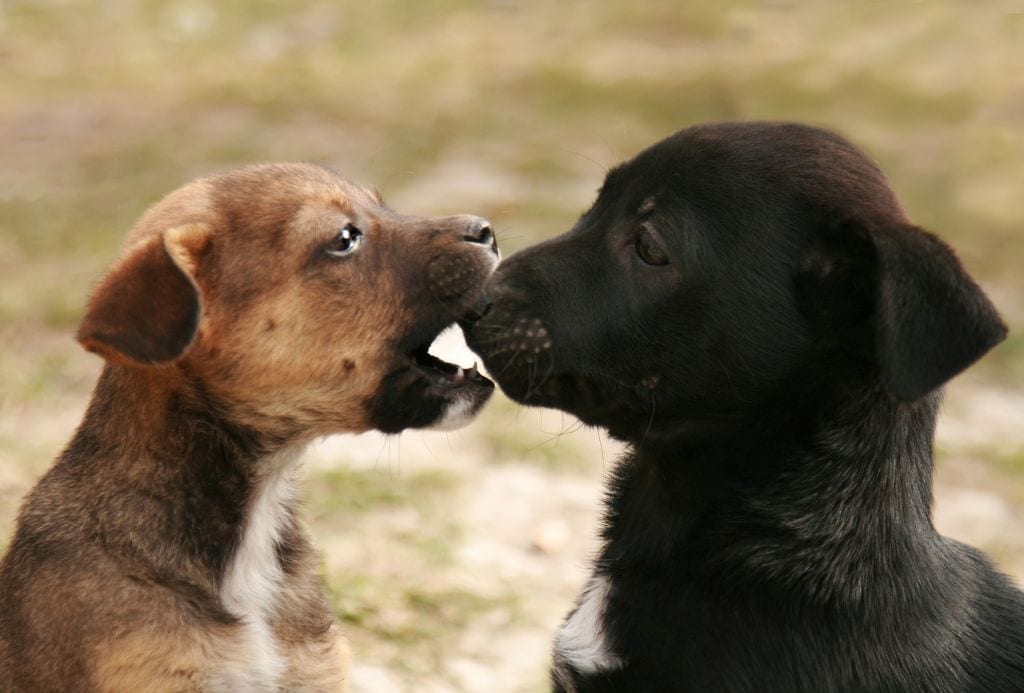What does puppy socialization mean to you? How do you know you are making positive progress with socializing your pup? Socialize your dog to decrease stress, improve tolerance for people and children, and reduce unpredictable or negative reactions to unfamiliar situations. Expose your pet to numerous people, loud sounds, weird sights, large buildings, and busy streets.
What is Puppy Socialization?
Socialization for puppies is providing your young dog with the tools to remain emotionally stable and amiable in an environment not necessarily natural for them. Pups retain a friendly demeanor and are comfortable in a human-run society. Pet dogs get early exposure and conditioning to different sounds, smells, sights, various people, places, and other dogs.
Why Is Pup Socialization Important?
Puppies do not arrive into the world knowing how to behave any more than an infant would. Their brief stints with their mothers and littermates before adoption gives them an introduction to being a dog.
If a puppy stayed with his litter, he would continue to learn social cues from his mother and siblings. He would also gain confidence through the exploration of an unpredictable environment.
Socialization not only familiarizes your puppy with numerous situations to diminish uncertainty and fear but also teaches him how to cope when he feels unsure. Exposing your puppy to all kinds of people, other dogs, and environments will help decrease the likelihood of his adapting antisocial behavior or becoming a nervous stressed-out wreck.
When to Start Socialization
You need to think about your pup’s socialization as soon as you adopt him. The critical window for influencing your puppy’s future interactions are between the ages of six and sixteen weeks. Ideally, the breeder will start handling your puppy even as early as a few days old.
Your work begins as soon as your puppy arrives at your home. Everyone in the family should handle him, and he should get exposure to the other pets. Be cautious if you have a young dog with an uncertain vaccination status or an incomplete history.
How to Socialize a Pup
Start Socialization Slowly
Beginning your pup’s exposure to new people right within your family is one way to start slowly and not overwhelm him. You should not rush any training, and that includes socialization. Exposing your puppy to too much stimulus at once can damage the trust and go against the confidence you are trying to establish in the first place.
Make strides in the teachings outside of your family with small steps. Learn your puppy’s body language so you can gauge his discomfort. You want to avoid unfamiliar situations becoming a negative experience. Never allow uncertainty to escalate into fear. Do not force an association with a person, another animal, or a place where your puppy clearly seems distressed.
Use a leash as a tool to prevent your puppy from running away. Do not ever drag your dog to where he feels uncomfortable. Moreover, do not pet or soothe your puppy for anxious or fearful behavior because it will reinforce antisocial feelings.
Make Socialization Positive
Approach socializing your puppy as a training exercise. Training works best with positive reinforcement. As you progress from one setting to another, remain encouraging and offer your puppy praise, treats, or fun. You can use your puppy’s favorite toy if you can easily distract him from any negative feelings with a play break.
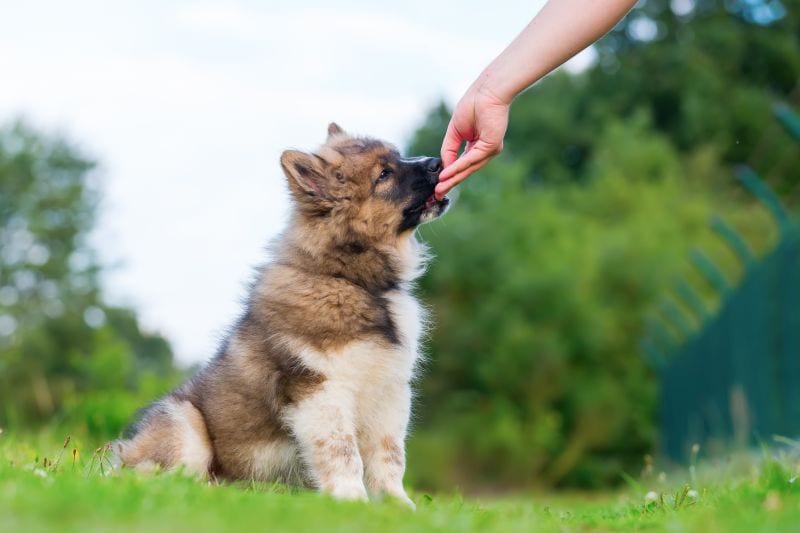
Allow your pup to explore his environment with natural curiosity. Arm strangers with treats. If you clicker train, you can utilize the sound system to help socialize your puppy. The clicker, as you know, signals your dog that something positive is happening. Give shy pups space to approach unfamiliar objects and people on their own.
Can You Socialize Your Puppy Before Vaccinations?
You have no choice other than to socialize your puppy before he finishes his vaccination series. A typical puppy vaccine schedule includes parvo and distemper boosters approximately every three to four weeks between two and four months of age. His critical socialization window is between six and fourteen weeks.
Despite your understandable concerns about serious infectious diseases your puppy may be exposed to, the ramifications from antisocial behavior are far more likely. Experts emphasize the importance of socialization before vaccine completion.
You can reduce your puppy’s risks of parvo or distemper by only associating with other pups who are up to date on veterinary checks and vaccines. You also should make sure your puppy has received his first set of vaccines and a dewormer.
Dog parks should be off-limits for the initial 16 weeks. However, disinfected obedience classrooms and controlled visits with the relative’s dogs should be part of your pup’s routine.
Your Puppy’s Meet and Greets
People
Your puppy needs exposure to various people. If you are a single person who lives alone except for another dog or a cat, you need to be especially vigilant about introducing your pup to a plethora of your friends and relatives.
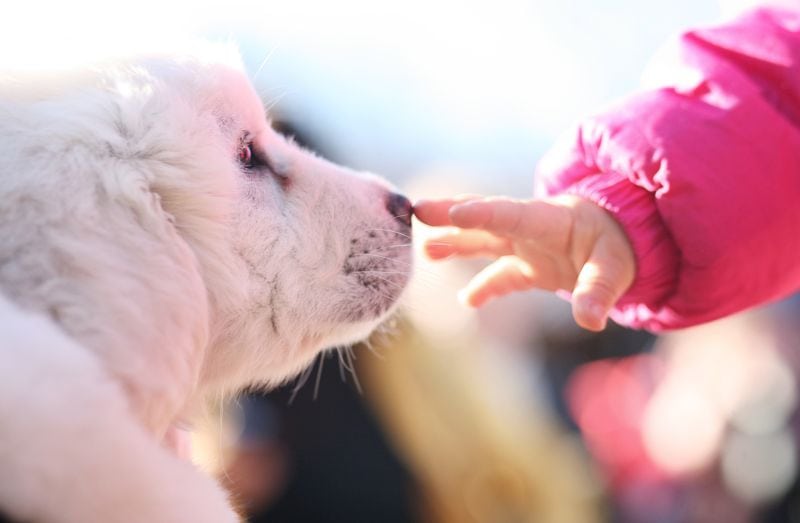
Your pup’s new collection of friendly faces should include men, women, and children. Seniors should be in the mix as well. People of different cultures and from as many occupations as possible should be picking up your puppy and giving him friendly pats. Visit in the yard and inside different homes, letting your puppy know that he could experience new sights and smells at any time.
Accessories
You are proud of yourself for introducing your puppy to everyone you know and ensuring every encounter is positive if not fun. But everyone knows the dog who does not like people wearing baseball caps or men with beards.
Do not neglect to expose your puppy to various accessories that people use. Umbrellas, velcro, and slickers are scary because of the way they look or the strange noises they make.
Have ladies you know put their hair up in crazy styles or wear outlandish hats. Include anything you can think of like billowing skirts, veils, leather boots, trailing scarves, bulky purses, sunglasses, and trailing scarves. Make sure your young dog sees men with facial hair and learns that beards and mustaches are all normal. Ask people to dress in hospital scrubs, suits, trench coats, and gloves.
Places
By going to several different places, your puppy can become familiar with different atmospheres and smells. Use discretion the younger your puppy is, always mindful of vaccine history.
Your pup’s feet do not have to touch the ground whenever you are in doubt. For example, you might carry your puppy if you take him downtown or into the groomer’s office. You can also use a stroller. Places like an office or your cousin’s home where there are no other dogs will not require as many precautions and can still serve to socialize your pet.
Handling
You should accustom your dog to different forms of handling by several groups of people. Perhaps you do not anticipate carrying your Akita in your arms anywhere as an adult, but you need to encourage people to touch your puppy. Encourage different individuals to pet and praise your pup.
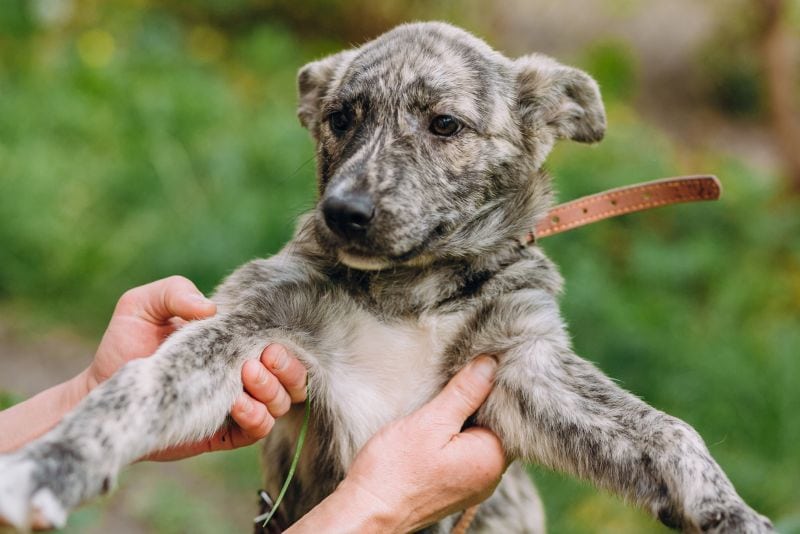
Small breed puppies should be comfortable with various people picking them up or holding them without angst. Poodles and other breeds who need haircuts should get comfortable with the type of handling they would associate with grooming. Introduce your pup to groomers and begin puppy clips at an early age.
Exposure to the veterinarian will come by regular vaccinations, but you also need to consider trainers and other people who may need to handle your dog with more contact than a casual pat. Ensure all contact and experiences are positive.
Make sure your puppy gets substantial exposure to children. Education is a two-way street. As your pup learns that children are nothing to fear, kids should learn to remain calm and to treat dogs with respect and gentleness.
Do not neglect socializing your puppy to having you handle his feet and mouth. Simple handling familiarity will be helpful for nail trims and teeth brushing.
Sounds
You probably know that your dog hears much better than any person. He will hear sounds much further away and across a greater range of frequencies. Better acuity translates to more sensitivity to sounds, adding to your socialization concerns.
You will bring your puppy into a world full of unfamiliar noises you take for granted. While it is obvious hunting dogs should get used to gunshots, your puppy needs to learn that the vacuum, doorbell, television, radio, lawnmower, and blender are harmless and normal. Thunder and fireworks scare so many dogs, and early socialization and desensitization could help.
Vehicles
Another part of your life you do without thinking is drive. Your dog should become accustomed to riding with you as soon as possible. Teach your puppy through frequent trips that a car ride is a normal and enjoyable part of life.
You will need to cart your dog to the vet or may want to take him to the mountains or on another adventure. A fearful dog or one prone to get carsick in the car is no fun. You also do not want your dog walking all over in the backseat.
Socialization teaches your puppy how to be a calm and safe passenger without whining or barking from anxiety. In the same vein, you need to expose your puppy to parked cars and vehicles driving down the street. Educate your pup early that cars are not appropriate to chase or jump at.
Teach your puppy proper etiquette on crossing the street with you. You can incorporate street education with leash training.
Surfaces
Dogs are domesticated, but your world still has plenty that is foreign to them. Your puppy will learn much through his feet, so it makes sense that socialization includes surface acclimatization.
Have you ever seen a dog who will not venture onto a marble floor out of fear? Teach your puppy about different floor types. He should learn how to walk on a slick surface like hardwood or tile. He should also become familiar with the feel of rubber, pavement, and synthetic turf under his feet.
Moreover, your puppy should learn not to be fearful on an elevated surface such as on an examining table or scale. Also, consider tubs as well as stairs and different carpets. If you cannot find naturally-occurring various surfaces, you can pick up samples at various recycling or retail centers.
Other Animals
Your pup’s most important social interactions after people are with other dogs. Since so many people enrich their lives with dogs, your pup should be able to relate safely and happily with others of his species.
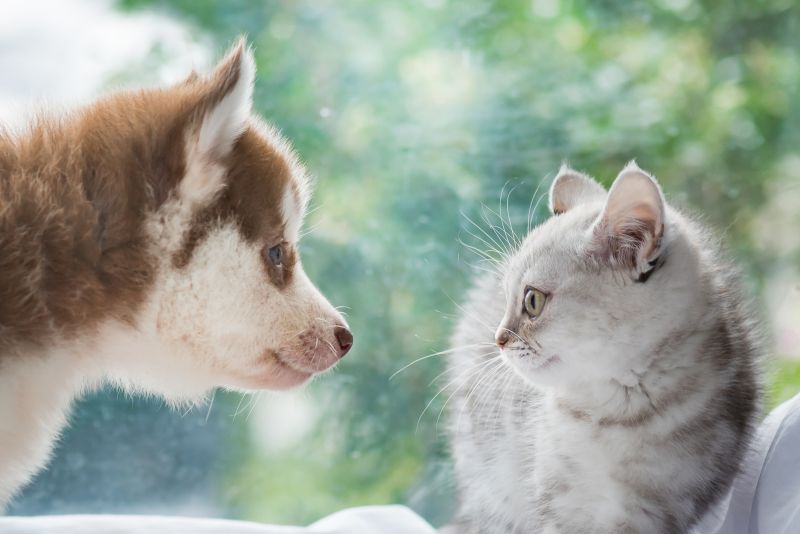
Dogs rely more on body language to communicate with each other than people. Your pup learns the appropriate posturing through socializing with other dogs, and it is most effective and long-lasting before three months of age.
While you should not choose a pet store or other well-frequented venue to have your young pup meet other dogs, you also cannot wait until a complete vaccination program.
Carefully orchestrate frequent encounters with other dogs through play dates or puppy classes. Try to match puppies according to similar ages and sizes.
Socialize your dog with birds and rodents with great care. Remember, dogs are predatory and some retain a high prey drive that no amount of socialization will ever erase.
Cats often belong in a category to themselves. A great many dogs do fine with cats they grow up with, a recap on early socialization. Many dogs see cats outside their household as fair game to chase and torment.
Finally, other species communicate differently than canids and some will not accept a puppy as a friend. Sometimes socialization is teaching your pet that some things are off-limits.
Moving Objects
You may not think twice about strollers, skateboards, or bicycles, but your puppy may have a strong reaction to moving objects. Animals in the wild rely on their reaction to fast movements for survival. A quick reprimand by a stallion establishes herd dominance, or a mother wolf’s quick snap offers a reprisal faster than you can blink.
Your small puppy’s bad experience with an out-of-control baby stroller could make him fearful of anything similar. Your German Shepherd could learn to chase scooters and be a menace to your neighbors forever. You should expose your dog to fast-moving objects with and without occupants or operators. Where practical, expose your pup to escalators and moving walkways.
Enclosed Spaces
Although there is a significant amount of controversy surrounding the idea of whether or not dogs are den animals, it is beneficial to accustom your puppy to spend some time in a crate. If your dog can begin to see a crate as a safe place and somewhere to go for privacy, it will help him on his way to becoming a well-adjusted dog.
Crates facilitate house training and other learning as well as transportation. Dogs seem to tolerate confined spaces better than people. They still need familiarization, especially with elevators and possibly your car.
Consider Puppy Socialization and Training Classes
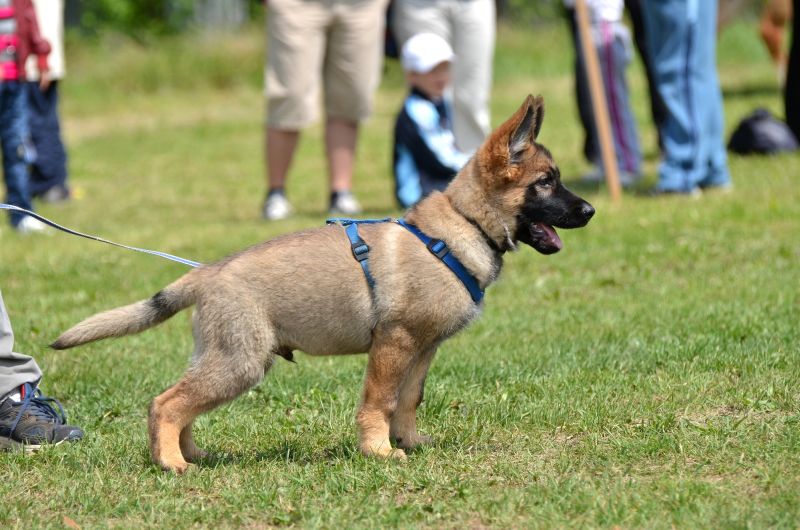
Most puppies can benefit from training classes as structured groups can serve multiple purposes. Puppy classes give your dog basic obedience training, socialize him with other canids, and expose him to an unfamiliar environment with novel smells and sounds. Again, do not wait for vaccine completion to consider a puppy class. Check to see that facilities are clean and that any prospective trainer is rigorous about checking the vaccination status of all attendees.
What About Older Dogs
Unfortunately, canids do not have much potential for socialization outside a surprisingly narrow age window. For some breeds, the cutoff for effective development of social skills may be as early as 12 weeks.
Have you seen the rescue dog who always remains afraid of men? Abused dogs who received early socialization have a chance to regain their confidence and trust again. If you fail to properly socialize a puppy by four months old, the chance is slim he will ever fully develop the trust he lost.
That being said, you should not stop socializing your dog after four months. Sensitive working dogs such as German Shepherds continue to experience social progression well into their second year. However, after the window closes, your dog’s ability to gain social skills around novel people or unfamiliar objects decreases drastically. Affability and openness to novelty give way to fear or suspicion.
Conclusion
One of your most vital undertakings as a new dog owner is to socialize your puppy. You have a small time frame to expose your pup to as many new sights, smells, and sounds as possible to create a well-adjusted, steady, even-tempered dog. Well-socialized dogs do not overreact to provocation and learn to discern between danger and a non-threatening occurrence. Dogs who never obtain the appropriate exposure to different people and places can display a myriad of antisocial behaviors.
- Dangerous and sometimes unprovoked attacks
- Skittish – Cowering, tucked tail
- Fear biting – Always act like they feel cornered
- Jumping on people
- Aggression towards certain groups of people – i.e. children, men
- Poor communication with other dogs – Mounting, overly submissive, fighting
- Exaggerated response to loud or unfamiliar noises
We hope you enjoyed this information, whether you are a new pet owner or a seasoned dog lover. If you know someone who is thinking about getting a puppy or wants to learn more about dogs, share this article.
